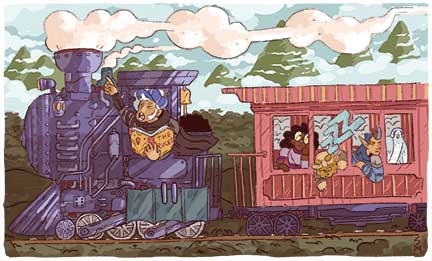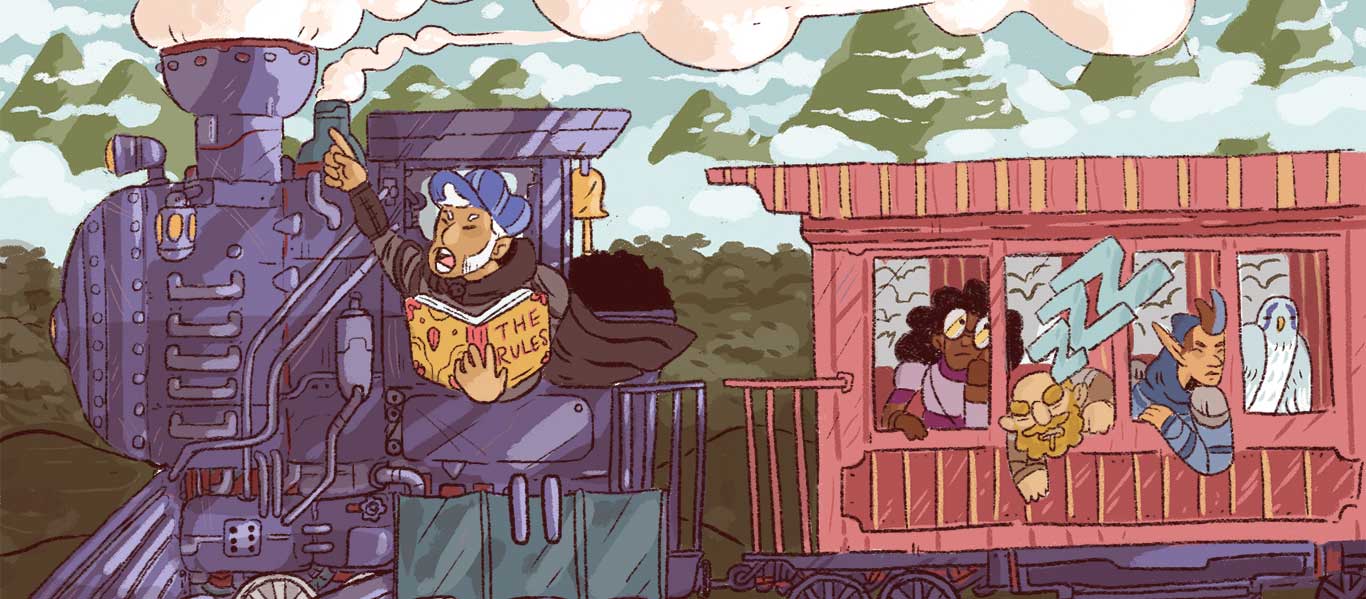Adventure Craft: Going Off the Rails
- January 8, 2019
- Articles
- Posted by Chris Roberson
- Comments Off on Adventure Craft: Going Off the Rails
In gaming terms, “railroading” is when a Game Master tries to force a campaign to unfold in a particular way, driving player characters to follow a predetermined path rather than giving them the freedom to chart their own course. Since so much of the fun of role-playing is in collaboration and improvisation, that can rob the gaming experience of its most essential joys. And I find that the same is true of a storyteller trying to force a story to unfold in a particular way, even if it doesn’t make sense for those particular characters. When characters make choices simply to advance the plot, or behave in arbitrary ways simply to move the action to a particular setting, then the storyteller has made the mistake of putting the plot ahead of the characters.
As a child of the ‘70s and ’80s, role-playing games were a big part of my formative years. And they played an important role in my development as a writer, as well—not in terms of the genres I write in or the kinds of stories I tell, but in the way that I approach the process of storytelling itself. In nearly every project I tackle, there is a point at which I put aside any plans I had for how the story might unfold, and see what the characters would do in those circumstances and what decisions they would logically make. And in those moments, I often find that I feel like a Game Master at a table following the characters to an interesting story, rather than a railroad conductor trying force them to go in one particular direction.
A story is not an itinerary, and a setting is a map that the characters explore.
Sitting around a table with friends rolling dice is always fun, but I’ve often found that I derive just as much enjoyment from sitting alone in my room reading rule books and campaign modules. I love digging into the lore of a setting, studying up on magic systems or the mechanics of combat encounters, or poring over maps and imagining possible adventures that could take place there. I’ve read manuals and sourcebooks for any number of games that I never even ended up playing.
 In much the same way, worldbuilding and research are often my favorite part of the creative process. Whether it’s a question of researching a historical period and a geographical setting for a story set in a real place and time, or building a world from the ground up for one set in a fictional location, I try to learn as much as possible about a setting long before I start figuring out what will happen in a story. In some cases, I get to know the setting long before I even know who the characters in the story will be.
In much the same way, worldbuilding and research are often my favorite part of the creative process. Whether it’s a question of researching a historical period and a geographical setting for a story set in a real place and time, or building a world from the ground up for one set in a fictional location, I try to learn as much as possible about a setting long before I start figuring out what will happen in a story. In some cases, I get to know the setting long before I even know who the characters in the story will be.
I usually work out the mechanics of the world before getting to know the characters, as well. Is it a fantasy setting where magic is real? Then how does magic work there, who can work it and who can’t, what is possible for a character to do and what isn’t? Or if it is a science fictional setting, does it follow all of the known laws of physics, or are there special rules that apply? How about things like psionic powers, or time travel, or FTL drives? In short, before working out what might happen in a story, I figure out what could happen, establishing boundaries within which the characters will have to operate.
Then, once I know as much as possible about the world and how it works, I figure out who the characters are, and then let them show me what the story is. Or, rather, I drop the characters in that setting and follow them to the most interesting plot.
I’m sure that every Game Master has had the experience of working out all sorts of possible encounters that the player characters simply walk by without ever noticing, or creating non-player characters that the players never meet, or mapping out dungeons or taverns that the players never step foot in. And the same is true of a writer doing all of the worldbuilding and research for a setting, only to find that so much of it doesn’t fit into the story that they end up telling. Because if a particular plot point doesn’t make sense in context of the characters and the choices that they would logically make, whether it involves visiting a particular location or encountering a particular menace or exploring an interesting corner of that world, then it doesn’t belong in the story, no matter how much the writer might have fallen in love with the idea.
And there is also the danger of falling a little too much in love with a given aspect of a setting or situation, some interesting little bit of historical trivia (in a period piece or story set in a real place and time) or really cool little bit of lore (in an imagined world), that just doesn’t make sense to include in the story at hand. As the writer I know things about the world that the characters aren’t necessarily going to know, and that it wouldn’t even make sense for them to know. Attempting to shoehorn it into a story where it doesn’t belong only threatens to hurt the story in the long run. And so, just like a Game Master who knows that the player characters might uncover some clever puzzle or valuable bit of treasure if they would only open that door that they just walked by or turn left down the road instead of right, I have to take some comfort in the fact that I can save that little bit of unused business and maybe find a way to use it in another story somewhere down the line.
There are as many different ways that a writer can approach telling a story as there are different writers. There is no one right way to handle it, and no wrong way either, but there are definitely approaches that tend to be more creatively fruitful, and those which tend to be less successful. Some writers like to outline everything in advance before ever writing a single word, while others prefer to dive right in without any plan in place and discover the story as they write it. And both approaches have their advantages and disadvantages—outlining everything in advance allows the writer a greater degree of control over the structure of a story, but runs the risk of making the story too mechanical and sterile; discovering the story as you go along allows for more flexibility and invention, but you run the risk of following the story too far down paths that don’t end up leading anywhere interesting, requiring a lot of rewriting to get things back on track.
But speaking as someone who tends to rely heavily on outlines, I’ve found that it’s important not to get too locked into the details of a plot early on. It’s always necessary to allow room for improvisation, because otherwise you run the risk of railroading your characters into situations and decisions that don’t make sense for them. These days, I tend to adapt my process to the project at hand, sometimes doing extensive outlines and other times setting out with just a general idea of where things might go. But in either case, I always make a point to include that improvisation stage somewhere along the way. I put the characters in a situation, present them with a problem or a choice, and then think about what would make the most sense for those particular characters to decide or how they would most realistically react. Oftentimes the characters end up surprising me, and stories head off in directions that I would never have anticipated, and I end up exploring parts of the map that I didn’t think we’d ever get to discover.
There are, of course, times when the characters that I have created for a story don’t lend themselves well to making interesting choices, or the stories that make the most sense for them don’t have room for any of the interesting things that I know about the setting. And in those instances, the problem might not be with the plot or the setting but with the characters themselves. I have simply chosen the wrong characters, and maybe they don’t fit in that world. Maybe they lack the appropriate motivations or interests to navigate that setting in an interesting way. And so, like a Game Master running a campaign again for a different group of player characters, sometimes the best thing to do is go back to the beginning and see if a more interesting story might be possible if I put someone else in those situations.
And finally, to flip the analogy around from writers back to Game Masters, there may be times when, despite their best intentions, a Game Master finds themselves railroading their player characters through a narrative of our own making rather than letting the players follow their own path. And just like a writer having to step back and let the characters drive the action, there are ways that the Game Master can shift gears and put the player characters back in the driver’s seat. For example, the GM can break a planned narrative down into its simplest components and build potential situations rather than an overarching plot; focus on improvisation, both on the part of the GM and the players, and let the narrative develop more organically out of the players’ choices. Or, rather than trying to drive player characters to follow a predetermined path, develop hooks that relate directly to the player characters’ own motivations, backstories, and personality traits; help steer the players to make interesting choices by building a story around who the player characters are and how they typically react, rather than forcing them to fit into an existing narrative. And if there is still some ultimate destination that you think the players would enjoy reaching but they keep turning down the wrong paths, look for new ways to connect the choices that the player characters do make with the larger narrative you have in mind; they might travel a different route than you originally envisioned, but they can still reach the same destination eventually.
 Chris Roberson is the co-creator of iZOMBIE (with Mike Allred) and EDISON REX (with Dennis Culver), and the co-writer of HELLBOY AND THE B.P.R.D and other titles set in the world of Mike Mignola’s Hellboy. In addition to his numerous comics projects, he has written more than a dozen novels and three dozen short stories.
Chris Roberson is the co-creator of iZOMBIE (with Mike Allred) and EDISON REX (with Dennis Culver), and the co-writer of HELLBOY AND THE B.P.R.D and other titles set in the world of Mike Mignola’s Hellboy. In addition to his numerous comics projects, he has written more than a dozen novels and three dozen short stories.


